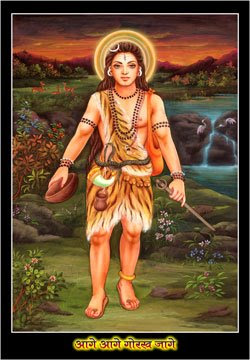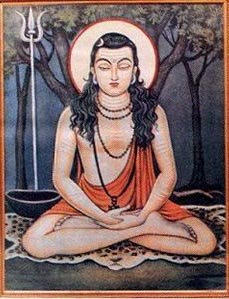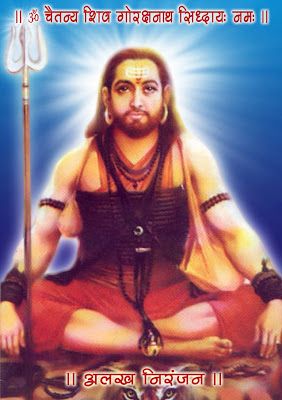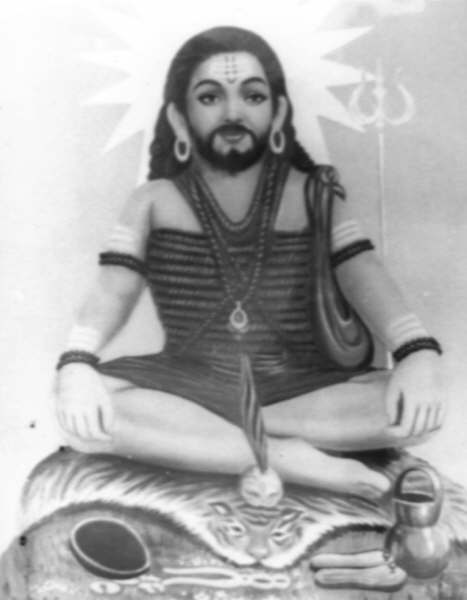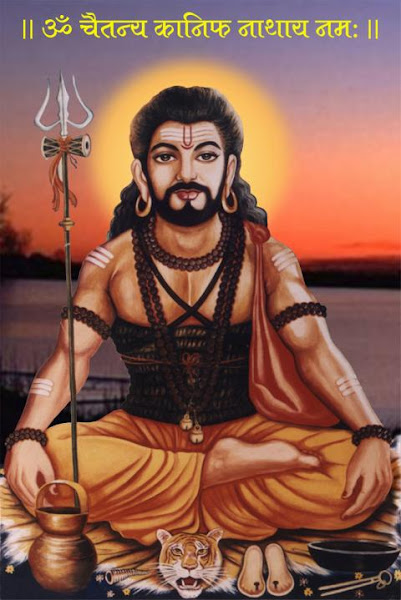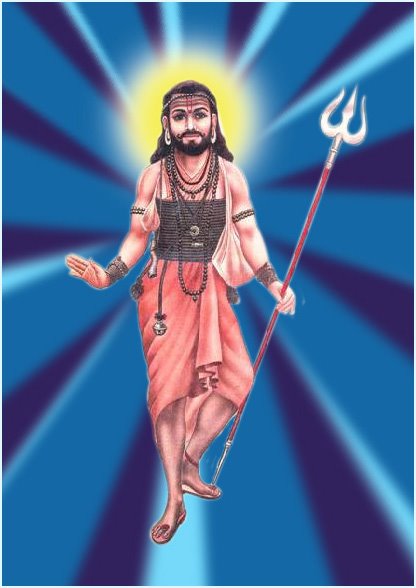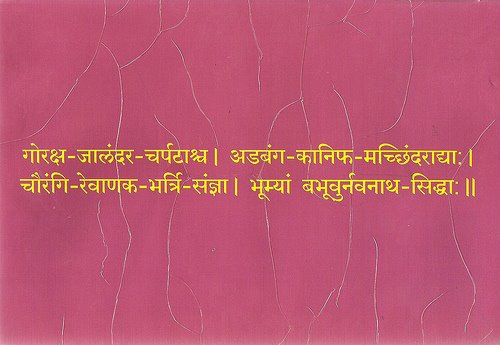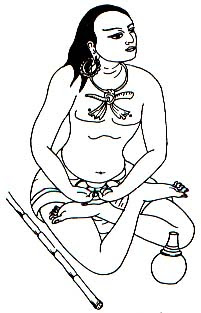
Goraksha-Paddhati
The importance of the Goraksha-Paddhati (“Tracks of Goraksha”) can be gauged by the fact that many of its verses are found scattered throughout the later literature of Hatha-Yoga. It is unlikely to have been authored by Goraksha, however, because its concepts and terminology belong to the twelfth or thirteenth rather than the tenth century. This text is here translated in full for the first time, based on the Sanskrit edition by Khemarвja Shrоkrishnadвsa (Bombay).
Part I
Bowing to the Blessed Вdinвtha-his own teacher, Hari, the sage and yogin-Mahоdhara has undertaken to present a commentary on Goraksha’s teaching (shвstra) that provides a proper understanding of Yoga. (1.1)
I venerate the blessed teacher, the supreme bliss (parama-вnanda ) who is an embodiment of the innate bliss (sva-вnanda) and in whose mere proximity [my] body becomes blissful and conscious. (1.2)
Devotedly saluting his teacher as supreme wisdom, Goraksha expounds what is desired to bring about the ultimate bliss in yogins. (1.3)
With the desire to benefit yogins, he declares the Goraksha-Samhitв. By comprehending it, the supreme State is surely attained. (1.4)
It is a ladder to liberation, a [means of] cheating death, by which the mind is turned away from pleasure (bhoga) and attached to the transcendental Self (parama-вtman). (1.5)
The most excellent ones resort to Yoga, which is the fruit of the wish-fulfilling tree of revelation (shruti), whose branches are frequented by the twice-born, and which pacifies the tribulations of existence. (1.6).
They name posture, breath restraint (prвna-samrodha), sense-withdrawal, concentration, meditation, and ecstasy as the six limbs of Yoga. (1.7)
There are as many postures as their are species of beings. [Only] Maheshvara [i.e., Shiva] knows all their varieties. (1.8)Of the 840,000, one for each [100,000] has been mentioned. Thus Shiva created eighty-four seats (pоtha) [for yogins]. (1.9)
Of all the postures, two are special. The first is said to be the hero’s posture (siddha-вsana); the second is the lotus posture (kamala-вsana). (1.10)
[The yogin] should firmly place one [i.e., the left] heel against the perineum (yoni-sthвna), while placing the other heel above the penis and pressing the chin against the chest (hridaya). With the senses restrained like a log, he should direct his gaze steadily at the [third eye] between the eyebrows. This is said to be the hero’s posture, which bursts open the door to liberation. (1.11)
Placing the right [lower] leg on top of the left [thigh] and the left [lower leg] on top of the right [thigh], firmly grasping the big toes with the hands crossed behind the back, while placing the chin on the chest, he should look at the tip of the nose. This is said to be the [baddha or “bound”] lotus posture, which removes various kinds of diseases. (1.12)
How can those yogins succeed who do not know the six centers, the sixteen props, the 300,000 [channels], and the five ethers/spaces in their own body? (1.13)
How can those yogins who do not know their own body as a single-columned dwelling with nine openings and five divinities (adhidaivata) be successful? (1.14)
The “prop” [i.e., the mыlвdhвra lotus at the base of the spine] has four petals. The svвdhishtвna has six petals. At the navel is a ten-petaled lotus, and at the heart [is a lotus having as many] petals as the number of solar [months, i.e., twelve]. (1.15)
At the throat is a sixteen-petaled [lotus] and between the eyebrows is a two-petaled [lotus]. At the brahmic fissure (brahma-randhra), at the great path, [there is a lotus] called “thousand-petaled.” (1.16)
The “prop” (вdhвra) is the first center; svвdhishthвna is the second. Between them is the perineum named kвma-rыpa. (1.17)
The four-petaled lotus called “prop” is at the place of the anus (guda-sthвna). In the middle of it is said to be the “womb” (yoni) praised by adepts under the name of desire (kвma). (1.18)
In the middle of the “womb” stands the great phallus/symbol [of Shiva] facing backward. He who knows the disk, which is like a [brightly shining] jewel, in [its] head is a knower of Yoga. (1.19)
Situated below the penis is the triangular city of fire, flashing forth like lightning bolts and resembling molten gold. (1.20)
When in the great Yoga, in ecstasy, [the yogin] sees the supreme, infinite, omnipresent Light, he does not experience [any further] coming and going [i.e., births and deaths in the finite world]. (1.21)
The life force arises with the sound sva. The resting place of this [life force] is the svвdhishthвna[-cakra]. Thus the penis is named after this place as svвdhishthвna. (1.22)
Where the ”bulb” (kanda) is strung on the sushumnв [i.e., the central channel] like a jewel on a thread, that region is called the manipыraka-cakra. (1.23)
So long as the psyche (jоva) roams at the great twelve-spoked center [at the heart], which is free from merit (punya) and demerit (pвpa), it cannot find Reality. (1.24)
Below the navel and above the penis is the “bulb” (kanda), the “womb” (yoni), which is like a bird’s egg. In it the 72,000 channels originate. (1.25)
Among these thousands of channels, seventy-two are described. Again, of these carriers of life force ten are mentioned as primary. (1.26)
Idв and pingalв, and sushumnв as the third, as well as gвndhвrо, hasti-jihvв, pыshв, yashasvinо, . . . (1.27)
. . . alambushв, kuhыё and shankhinо as the tenth are mentioned. Yogins should always understand this network (cakra) composed of channels. (1.28)
Idв is located on the left side; pingalв is located on the right. Sushumnв is in the central place, while the gвndhвrо is in the left eye. (1.29)
Hasti-jihvв is on the right, and pыshв is in the right ear, while yashasvinо is in the left ear and alambhushв is in the mouth. (1.30)
Kuhы is at the place of the penis (linga) and the shankhinо at the place of the anus. Thus there are ten channels, [each of which is] connected with an opening. (1.31)
Idв, pingalв, and sushumnв are connected to the path of the life force. The [ten] are always carriers of the life force, [and they are respectively associated with] the deities of moon (soma), sun, and fire. (1.32)
Prвna, apвna, samвna, udвna, as well as vyвna are the [principal] “winds.” Nвga, kыrma, krikala, devadatta, and dhanamjaya [are the secondary types of life force in the body]. (1.33)
Prвna dwells at the heart; apвna is always in the region of the anus; samвna is at the location of the navel; udвna is in the middle of the throat; . . . (1.34)
. . . vyвna pervades the [whole] body. [These are] the five principal “winds.” The five beginning with prвna and the [other] five “winds” beginning with nвga are well known. (1.35)
Nвga is said to be [present in] eructation; kыrma is said [to manifest in] the opening [of the eyes]; krikara [or krikala] is known as causing sneezing; devadatta [is present in] yawning. (1.36)
Dhanamjaya is all-pervasive and does not even quit a corpse. These [ten forms of the life force] roam in all the channels in the form of the psyche (jоva). (1.37)
As a ball struck with a curved staff flies up, so the psyche, when struck by prвna and apвna [in the form of the in-breath and out-breath], does not stand still. (1.38)
Under the force of prвna and apвna the psyche moves up and down along the left and right pathways, [even though] it cannot be seen because of its mobility. (1.39)
Like a falcon tied with a string can be pulled back when it has taken off, so the psyche, tied by the qualities (guna) [of Nature] can be pulled back by means of [controlled] prвna and apвna. (1.40)
Apвna pulls prвna, and prвna pulls apвna. [These two forms of the life force are respectively] situated above and below [the navel]. The knower of Yoga joins both [to awaken the serpent power]. (1.41)
[The psyche] exits [the body] with the sound ha and reenters it with the sound sa. The psyche continually recites the mantra “hamsa hamsa.” (1.42)
The psyche continually recites this mantra 21,600 times day and night. (1.43)
The gвyatrо[-mantra] named ajapa bestows liberation upon yogins, and merely by the desire [to recite] it one is released from all sin. (1.44)
Knowledge like this, recitation (japa) like this, and wisdom like this did not exist [before now] nor will exist [ever again]. (1.45)
The life-sustaining gвyatrо is born from the kundalinо. He who knows this knowledge of the life force, the great science, is a knower of the Vedas. (1.46)
The kundalinо power folded into eight coils always resides above the “bulb,” closing the opening of the “brahmic gate” (brahma-dvвra) with its face. (1.47)
Through that gate one should go to the state of the Absolute beyond ill, [but] Parameshvarо is asleep covering that gate with her face. (1.48)
[When the kundalinо] is awakened through buddhi-yoga together with the mind and the breath (marut), it moves upward through the sushumnв like a needle drawing a thread. (1.49)
[When the kundalinо], having the form of a sleeping serpent and being splendid like a lotus fiber, is awakened through vahni-yoga, it moves upward through the sushumnв. (1.50)
Just as one forcibly opens a door with a key, so the yogin should break open the door to liberation by means of the kundalinо. (1.51)
Cupping the hands firmly and assuming the lotus posture while placing the chin tightly against the chest and [practicing] meditation in the mind (cetas), he should expel again and again the apвna air above, after having filled [the chest with it]. [Thus] upon releasing the life force, he acquires unequaled understanding (bodha) through the awakening of the power (shakti). (1.52)
He should rub his limbs with the liquid [i.e., the perspiration] produced by the effort. He should consume milk and abstain from bitter, sour, and salty [food]. (1.53)
He who practices [this kind of] Yoga should be a celibate (brahmacвrin) and a renouncer (tyвgin), living on a modest diet (mita-вhвrin). He will become an adept after a year. There should be no doubt about this. (1.54)
He who consumes oil-rich and sweet food, delighting in its taste and leaving a fourth part, is called a modest eater (mita-вhвrin). (1.55)
He who knows the kundalinо-shakti [situated] above the “bulb” and bestowing splendid liberation, but [causing greater] bondage for fools, is a knower of the Vedas. (1.56)
The yogin who knows the mahв-mudrв, nabho-mudrв, uddоyвna[-bandha], jalandhara[-bandha], and mыla-bandha partakes of liberation. (1.57)
Placing the chin on the chest, pressing continually the left heel against the perineum (yoni), and holding the extended right foot with the hands, [the yogin] should, after inhaling the air and holding it on both sides of the chest, expel it gradually. This great seal is said to remove people’s diseases.
After practicing [the mahв-mudrв first] with the lunar part [i.e., the left nostril], he should practice it with the solar part [i.e., the right nostril]. He should discontinue this seal after achieving an equal number [of repetitions]. (1.59)
[For the adept who is successful in the practice of the mahв-mudrв] there is no proper or improper [food]. All tastes are indeed without taste. Even virulent poison when swallowed is digested as if it were nectar (pоyыsha). (1.60)
For him who practices the mahв-mudrв, [all] diseases are eliminated, notably consumption, leprosy, constipation, abdominal swelling, and decrepitude. (1.61)
This mahв-mudrв that has been described brings great accomplishments for people. It should be diligently guarded and not given to anyone. (1.62)
The khecarо-mudrв consists in turning the tongue backward into the hollow of the skull while fixing the gaze between the eyebrows. (1.63)
He who knows the khecarо-mudrв does not experience sleep, hunger, thirst, fainting, or death from disease. (1.64)
He who knows the khecarо-mudrв is not troubled by grief, tainted by actions [or karma], or bound by anything. (1.65)
The mind (citta) does not move because the tongue assumes the khecarо. Because of this, the perfected khecarо is adored by all the adepts. (1.66)
The semen (bindu) is the root of [all] bodies in which the veins [i.e., the channels of the life force] are established. They constitute [all] bodies from the head to the soles of the feet. (1.67)
For him who [enters] the cavity above the uvula by means of the khecarо-mudrв, the semen is not wasted, [even if he is] embraced by a woman. (1.68)
So long as the semen remains in the body, how can there be fear of death? So long as the nabho-mudrв is maintained, the semen does not stir. (1.69)
Even if the semen has dropped into the “sacrifice consuming” (huta-вshana) [female womb], it moves back up again, having been stolen, when it is restrained by the power of the yoni-mudrв. (1.70)
Moreover, the semen is twofold: white and red. They call the white one shukra, while the red one is named mahв-rajas. (1.71)
The rajas is located at the place of the navel and resembles a red liquid. The bindu is located at the place of the moon [i.e., at the palate]. Their union is difficult to achieve. (1.72)
The bindu is Shiva; the rajas is Shakti. The bindu is the moon; the rajas is the sun. Only through the union of both does [the yogin] attain the supreme State. (1.73) When the rajas is activated by stirring the [kundalinо-]power through the breath (vвyu), then it achieves union with the bindu, whereupon the body becomes divine. (1.74)
Comments: The creation of a divine body (divya-deha), which is endowed with all the great paranormal powers, is the avowed goal of Hatha-Yoga. This stanza briefly mentions the esoteric process by which this is accomplished.
The shukra is joined with the moon; the rajas is linked with the sun. He who knows their coessential unity is a knower of Yoga. (1.75)The purification of the network (jвla) of channels and the stirring of sun and moon, as well as the drying up of [noxious bodily] liquids, is called mahв-mudrв. (1.76)
Just as a great bird takes to flight untiringly, so his [practice of] uddоyвna[-bandha] becomes a lion to the elephant of death. (1.77)
This upward lock (uddоyвna-bandha) is said [to be practiced] below the navel and at the back portion of the abdomen. There the lock is said [to be applied]. (1.78)
The jвlandhara-bandha [or throat lock] blocks the network of conduits (shiras) so that the water from the sky (nabhas) [i.e., the ambrosial liquid from the secret center in the head] does not drip down [into the abdomen]. Therefore [this practice] removes a host of diseases of the throat. (1.79)
By performing the jвlandhara-bandha, characterized by the [deliberate] constriction of the throat], the nectar does not fall into the fire, and the air is not agitated. (1.80)
Pressing the left heel against the perineum, [the yogin] should contract the anus while pulling the apвna [life force] upward. [Thus] is the “root lock” (mыla-bandha) to be performed. (1.81)
By unifying apвna and prвna, urine and faeces are reduced. Even if he is old, he becomes young again through the constant [practice of] the root lock. (1.82)
Assuming the lotus posture, holding the body and head straight while gazing at the tip of the nose, he should recite the imperishable om-sound in seclusion (ekвnta). (1.83)
The supreme Light is om, in whose morae (mвtrв) abide the deities of moon, sun, and fire [together with] the realms [symbolized by the words] bhыh, bhuvah, and svah. (1.84)
The supreme Light is om, wherein abide the three times [i.e., past, present, and future], the three Vedas [i.e., the Rig-, Yajur-, and Sвma-Veda], the three worlds, the three intonations (svara), and the three deities [i.e., Shiva, Vishnu, and Brahma?]. (1.85)
The supreme Light is om wherein abides the threefold power (shakti) [consisting in] action, will, and wisdom, or brвhmо, raudrо, and vaishnavо. (1.86)
The supreme Light is om, wherein abide the three morae, namely the syllable a, the syllable u, and the syllable m known as the “seed-point” (bindu). (1.87)
The supreme Light is om. He should recite in words its seed-syllable (bоja), practice it with the body, and remember it with the mind. (1.88)
He who constantly recites the pranava, whether he be pure or impure, is not tainted by sin, just like a lotus leaf [is not stained by the surrounding] water. (1.89)
When the “wind” moves, the semen moves as well. When it does not move, [the semen also] does not move. [If] the yogin [desires to] attain stock-stillness (sthвnutva), then he should restrain the “wind” [i.e., the breath/life force]. (1.90)
So long as the “wind” remains in the body, the psyche is not released. Its departure [causes] death. Therefore he should restrain the “wind.” (1.91)
So long as the air is held in the body, the mind is free from ill. So long as the gaze [is expertly directed] between the eyebrows, how can there be fear of death? (1.92)
Therefore, out of fear of death, [even] Brahma is intent on breath control, as are the yogins and sages. Therefore one should restrain the “wind.” (1.93)
Through the left and right pathways [i.e., the nostrils], the hamsa goes forth (prayвna) [a distance of] thirty-six fingers outside [the body], wherefore it is called prвna. (1.94)
When the whole network of channels, filled with impurities, is purified, then the yogin becomes capable of controlling (samgrahana) the life force. (1.95)
The yogin [seated in] the bound lotus posture should fill in the life force through the lunar [nostril] and then, after holding it according to his capacity, expel it again through the solar [nostril]. (1.96)
Meditating on the moon disk, the nectar that resembles [white] curd or is like cow’s milk or silver, [the yogin practicing] breath control should be happy. (1.97)
Drawing in the breath (shvвsa) through the right [nostril], he should fill the abdomen gradually. Having retained it according to the rules, he should expel it again through the lunar [nostril]. (1.98)
Meditating on the solar circle, which is a mass of brightly burning flames located at the navel, the yogin practicing breath control should be happy. (1.99)
When the breath is filtered through the idв [i.e., the left nostril], he should expel it again through the other [nostril]. Sucking the air in through the pingalв [i.e., the right nostril] he should, after holding it, release it again through the left [nostril].By meditating on the two disks-of the sun and the moon-according to the rules, the host of channels become pure after three months. (1.100)
By purifying the channels, [the yogin] achieves health, the manifestation of the [subtle inner] sound (nвda), [the ability to] hold the “wind” according to capacity, and the flaring up of the [inner] fire. (1.101)
Part II
Through the restraint of the out-breath (apвna), the air, the life force (prвna), remains in the body. By means of only a single breath, [the yogin] should burst open the way into the “space” (gagana) [at the crown of the head]. (2.1)[Yogic] exhalation, inhalation, and retention are of the nature of the humming sound (pranava) [i.e., the sacred syllable om]. Breath control is threefold and endowed with twelve measures (mвtrв). (2.2)
The [internal] sun and moon are connected with the twelve measures; they are not fettered by the network of defects (dosha). The yogin should always know [these two principles]. (2.3)
During inhalation he should perform twelve measures [of the syllable om]. During retention he should perform sixteen measures, and during exhalation ten om-sounds. This is called “breath control” (prвnвyвma). (2.4)
In the initial [stage of breath control] twelve measures [should be done]; in the middle [stage] twice as many are deemed [appropriate]; in the superior [stage] thrice as many are prescribed. Such is the qualification of breath control. (2.5)
In the lower [stage], the “substance” (dharma) [i.e., sweat] is forced out; in the middle [stage] there is trembling; in the superior [stage] the yogin rises [from the ground]. Hence he should [carefully] restrain the air (vвyu). (2.6)
The yogin, [seated in] the bound lotus posture and saluting the teacher and Shiva, should practice breath control in solitude (ekвnta), with his gaze on the middle between the brows. (2.7)
Drawing up the apвna air, he should unite it with the prвna. When it is led upward with the [kundalinо] power, he is released from all sins. (2.8)
Having closed the nine gates (dvвra) [i.e., the openings of the body], having sucked in the air and holding it firmly, having conducted it to the “space” (вkвsha) [of the heart?] together with the apвna and the [abdominal] fire (vahni), starting up the [kundalinо] power and placing it in the head, for sure according to this rule, as long as [the yogin who is] joined with the abode of the Self [at the crown center] remains [thus], he is praised by the host of the great ones. (2.9)
Thus, breath control is the fire [feeding on] the fuel of transgressions (pвtaka). The yogins always call it the “great bridge” [leading across] the ocean of [conditioned] existence. (2.10)
Through posture, diseases are removed; through breath control, transgressions [are atoned for]; through sense-withdrawal, the yogin is released from [all] mental modifications (vikвra). (2.11)
Fondness for concentration [causes] steadiness (dhairya); through meditation, [he obtains] a marvelous [state of] consciousness. In [the condition of] ecstasy (samвdhi), having cast off auspicious and inauspicious karma, he attains liberation. (2.12)
Sense-withdrawal is said [to come about] with twice six breath controls; auspicious concentration is recognized [to come about] with twice six sense-withdrawals. (2.13)
Twelve concentrations are said to be meditation by the experts in meditation. Ecstasy (samвdhi) is said [to come about] with twelve meditations. (2.14)
Upon seeing in that ecstasy the supreme Light-infinite and facing all round-there is no activity or past or present karma. (2.15)
Having assumed the posture with the penis [between] the two heels, [and while] curbing the openings of the ears, eyes, and nasal passage with the fingers, and having inhaled the air through the mouth and having contemplated [the prвna] in the chest together with the fire [in the abdomen] and the apвna, he should hold them steady in the head. Thus, the lord of yogins, of the form of that [Reality], reaches sameness (samatв) with Reality (tattva) [i.e., Shiva]. (2.16)
When the air has reached the “space” (gagana) [at the heart?], a mighty sound is produced [resembling that of musical] instruments such as a bell. Then perfection (siddhi) is near. (2.17)
[The yogin who is] yoked through breath control [accomplishes] the removal of all [kinds of] illnesses. [The person who is] not yoked in the practice of Yoga [invites] the manifestation of every [kind of] illness. (2.18)
Various illnesses [such as] hiccups, cough, asthma, and afflictions of head, ear, and eyes are caused through the mismanagement (vyatikrama) of the air. (2.19)
Just as the lion, the elephant, and the tiger are tamed very gradually, lest they should kill the trainer-so the air is not [to be] employed [without great discipline]. (2.20)
He should let go of the air very gradually, and he should also inhale very gradually. Moreover, he should hold [the breath] very gradually. Thus, perfection is near. (2.29)
The eyes and other [senses] are roaming among their respective sense objects. Their withdrawal from them is called “sense-withdrawal” (pratyвhвra). (2.22)
Even as the sun reaching the third time-[quarter] withdraws its luster, so the yogin resorting to the third limb [of Yoga] [should withdraw every] mental modification (vikвra). (2.23)
As a tortoise contracts its limbs into the middle of the shell, so the yogin should withdraw the senses into himself. (2.24)
Recognizing that whatever he hears with the ears, whether pleasant or unpleasant, is the Self-the knower of Yoga withdraws [his hearing]. (2.25)
Recognizing that whatever he smells with the nose, whether fragrant or ill smelling, is the Self-the knower of Yoga withdraws [his sense of smell]. (2.26)
Recognizing that whatever he sees with the eyes, whether pure or impure, is the Self-the knower of Yoga withdraws [his vision]. (2.27)
Recognizing that whatever he senses with the skin, whether tangible or intangible, is the Self-the knower of Yoga withdraws [his sense of touch]. (2.28)
Recognizing that whatever he tastes with the tongue, whether salty or not salty, is the Self-the knower of Yoga withdraws [his sense of taste]. (2.29)
The sun withdraws the shower made of lunar nectar (amrita). The withdrawal of that [shower] is called “sense-withdrawal.” (2.30)
The one female, having come from the lunar region, is enjoyed by two, while the third, [in addition to] the two, is he who undergoes aging and death. (2.31)
In the place of the navel dwells the one sun, of the essence of fire. And the moon, of the essence of nectar, is always situated at the root of the palate. (2.32)The moon, facing downward, showers [nectar]; the sun, facing upward, devours [that lunar nectar]. Hence the [inverted] pose (karanо) is to be known so that the ambrosia can be obtained. (2.33)
[When] the navel is above and the palate is below, [that is to say, when] the sun is above and the moon is below, [then that is] known as the inverted pose. It should be learned from the teacher’s instructions. (2.34)
Where the triply fettered bull roars a mighty roar, the yogins should know that the center of the “unstruck” (anвhata) [sound is situated] at the heart. (2.35)
When the life force has reached the great lotus [at the crown of the head], after having approached the manipыraka-[center] and having passed on to the anвhata-[center], the yogin attains immortality (amrita). (2.36)
[The yogin] should contemplate the supreme Power (shakti), placing his tongue upward [in the brahmic] cavity as prescribed. [The nectar] trickling down from the sixteen-petaled lotus above is obtained by forcibly going up [to the palate with the tongue]. That faultless yogin who drinks from the tongue’s home (kula) the [special] sixteenth part of the exceedingly clear water of the kalв wave [flowing from] that [lotus] lives long with a body as tender as a lotus fiber. (2.37)
He should drink the cool surge [of air] with the mouth [shaped] like a crow’s beak. By regulating the prвna and the apвna, the yogin does not age. (2.38)
For him who drinks the prвna air with the tongue [placed at] the root of the palate, there will be the removal of all illnesses after half a year. (2.39)
He, having contemplated the whole nectar in the fifth center [called] “pure” (vishuddha), takes off by the up-path, having cheated the jaws of the [inner] sun [at the navel]. (2.40)
By the sound vi is meant the “swan” (hamsa) [i.e., the spontaneous breath]; shuddhi [or “purity”] is called “spotless.” Hence the knowers of the centers (cakra) know the center at the throat as [that which is] named vishuddha. (2.41)
[The life force], after escaping the jaws of the [inner] sun, rises of its own accord into the hollow at the end of the nose [after the yogin] has placed the nectar into that cavern. (2.42)
Having gathered the exceedingly clean water of the kalв of the moon [showering] from above the region of the throat, he should conduct it into the hollow at the end of the nose and then everywhere by means of the “space” [at the crown of the head]. (2.43)
The knower of Yoga who drinks the ambrosia (soma) by firmly placing the tongue upward [against the palate] undoubtedly conquers death within half a month. (2.44)
He who controls the root opening overcomes [every] obstacle and reaches [the state] beyond old age and death, like the five-faced Hara [i.e., Shiva]. (2.45)
By pressing the tip of the tongue against the great cavity of the “royal tooth” (rвja-danta) [i.e., the uvula] and contemplating the ambrosial Goddess, he becomes a poet-sage (kavi) within six months. (2.46)
The great flow above [the uvula] blocks all the [other] flows [in the body]. Whoever does not release the nectar [should first practice] the paths of the five concentrations. (2.47).
If the tongue constantly kisses the tip of the “hanger” [i.e., the uvula], causing the liquid (rasa) to flow [that tastes] salty, pungent, or sour, or is like milk, honey, and ghee, then diseases, old age, and death are removed, teachings (shвstra) and their auxiliaries are celebrated, and he will attain immortality and the eight [paranormal] qualities and attract the consorts (anga) of the adepts (siddha). (2.48)
After two or three years, the yogin whose body is filled with nectar has his semen (retas) go upward and [enjoys] the appearance of [paranormal] qualities like miniaturization (animan). (2.49)
Just as there is fire [as long as there is] fuel, and light [as long as there are] oil and wick, so also the embodied [psyche] does not leave the body when it is filled with the lunar part (kalв). (2.50)
In the case of a yogin whose body is daily filled with the lunar part, poison does not spread, even if he should be bitten by [the serpent king] Takshaka himself. (2.51)
[When the yogin is] equipped with posture, joined to breath control, and endowed with sense-withdrawal, he should practice concentration. (2.52)
Concentration is explained as steadiness of the mind and concentration upon the five elements in the heart individually. (2.53)
The earth [element] stationed in the heart is a resplendent yellow or yellowish square, with the syllable la and the lotus-seated [God Brahma]. Dissolving the life energies together with the mind therein [i.e., in the heart], he should concentrate for five ghatikвs [i.e., two hours]. He should always practice the stabilizing earth concentration to conquer the earth. (2.54)
The water element (ambu-tattva) resembling a half moon or white jasmine is located at the throat and is endowed with the seed syllable va of the nectar (pоyыsha), and always associated with Vishnu. Dissolving the life energies together with the mind therein [i.e., in the heart], he should concentrate for five ghatikвs [i.e., two hours]. He should always practice the water concentration, which burns up suffering for all time. (2.54)
The triangular fire element located at the palate and resembling a [red] cochineal is brilliant and associated with repha [i.e., the syllable ra], bright like coral, and is in the good company of Rudra. Dissolving the life force together with the mind therein [i.e., in the heart], he should concentrate for five ghatikвs [i.e., two hours]. He should always engage in the fiery concentration in order to conquer fire. (2.56)
The airy element, which is located between the eyebrows, resembles black collyrium and is associated with the letter ya and Оshvara as [the presiding] deity. Dissolving the life force together with the mind therein [i.e., in the heart], he should concentrate for five ghatikвs [i.e., two hours]. The yamin should practice the airy concentration so that he can traverse the sky. (2.57)
The ether/space element, which is located at the “brahmic fissure” (brahma-randhra) [at the crown of the head] and which is like very clear water is associated with Sadв-Shiva, the [inner] sound (nвda), and the syllable ha. Dissolving the life force together with the mind therein [i.e., in the heart], he should concentrate for five ghatikвs [i.e., two hours]. The ether/space concentration is said to break open the door to liberation. (2.58).
The five concentrations upon the elements [respectively have the power of] stopping, inundating, burning, destabilizing, and desiccating. (2.59)
The five concentrations are difficult to accomplish by means of mind, speech, and action. The yogin who is intelligent [in the use of these techniques] is released from all suffering. (2.60)
Recollection (smriti) obtains the single element (dhвtu) of all thoughts. Meditation is explained as the pure ideation (cintв) in the mind. (2.61)
Meditation is twofold, composite (sakala) and impartite (nishkala). It is composite owing to differences in performance, and impartite [meditation] is unqualified (nirguna). (2.62)
Assuming a comfortable posture (sukha-вsana), with internalized mind and externalized downward gaze (cakshus), and contemplating with focus the serpent (kundalinо), he is released from guilt (kilbisha). (2.63)
The first center [called] “prop” (вdhвra) is four-petaled and resembles gold. Contemplating with focus the serpent (kundalinо) [at that place in the body], he is released from guilt (kilbisha). (2.64)
Contemplating the Self at the six-petaled “self-base” (svвdhishthвna) [center located at the genitals], which resembles a true jewel, the yogin, gazing [steadily] at the tip of the nose, is [indeed] happy. (2.65)
Contemplating the Self as the jewel-city center luminous like the risen sun, [the yogin], gazing [steadily] at the tip of the nose, shakes the world. (2.66)
Contemplating Shambhu, who is stationed in the space (вkвsha) of the heart and is brilliant like the fierce sun, and maintaining the gaze at the tip of the nose, he assumes the form of the Absolute (brahman). (2.67)
Contemplating the Self in the heart lotus lustrous like lightning, while [performing] various [forms of] breath control and gazing at the tip of the nose, he assumes the form of the Absolute. (2.68)
Constantly contemplating the Self in the middle of the “bell” (ghantikв) at the pure (vishuddha) [center] shining like a lamp, he assumes the form of bliss (вnanda). (2.69)
Contemplating the Self, the God who is located between the eyebrows and resembles a true crest jewel, [while steadily] gazing at the tip of the nose, he assumes the form of bliss. (2.70)
The yogin who has conquered the life force and who always contemplates the Self, the supreme Lord of blue appearance at the spot between the eyebrows, while gazing at the tip of the nose, attains [the supreme goal of] Yoga. (2.71)
Contemplating the unqualified, tranquil, benevolent (shiva), all-facing [supreme Being] in the space [of the psychoenergetic center at the crown of the head], while gazing at the tip of the nose, he assumes the form of the Absolute. (2.72)
Where the [inner] sound [can be heard] in the ether/space, that is called the “command center” (вjnв-cakra). Contemplating the benign (shiva) Self therein, the yogin attains liberation. (2.73)
Contemplating the omnipresent Self, which is pure, in the form of space, and resplendent like sparkling liquid, the yogin attains liberation. (2.74)
Anus, penis, navel, heart lotus, the one above that [i.e., the throat], the bell, the place of the “hanger” [i.e., uvula], the spot between the eyebrows, and the space cavity [at the crown of the head] . . .(2.75). . . These nine places (sthвna) of meditation are mentioned by yogins as liberating one from limited reality and bringing about the emergence of the eight [paranormal] qualities. (2.76)Contemplating and knowing the unsurpassable light of the brilliant Shiva, who is identical with the Absolute, he is released. Thus said Goraksha. (2.77)
By controlling the circulation of the air at the navel and forcefully contracting the apвna root below, [which is] like the conductor of sacrifices [i.e., fire] and of subtle form like a thread, as well as by constricting the heart lotus and piercing the dalanaka, the palate, and the brahmic fissure, they reach the Void where God Mahesha [i.e., Shiva] enters the ether/space (gagana). (2.78)
Above the resplendent lotus at the navel is the pure circle (mandala) of the hot sun (canda-rashmi). I venerate the wisdom seal (jnвna-mudrв) of yoginоs, which removes the fear of death, is formed of wisdom, is of the same form as the world (samsвra), and is the mother of the triple universe, the giver of dharma for human beings, the praiseworthy Chinnamastв in the threefold subtle flow at the center of the triple path. (2.79)A thousand horse sacrifices or a hundred glorious libation (vвjapeya) [sacrifices] do not equal a sixteenth of a single yogic meditation. (2.80)The dual reality is explained as [being due to] superimposition (upвdhi). Superimposition is said to be a covering (varna), and Reality (tattva) is designated as the Self. (2.81)
By means of constant application (abhyвsa), the knower of all superimposition knows the condition of the Reality [revealed through] wisdom as different from [the world of appearance conjured up by] superimposition. (2.82)
As long as the potential (tanmвtra) of sound and so forth is presented to the ears and the other [sense organs], there is recollection (smriti), [which is the state of] meditation. Subsequently there will be ecstasy. (2.83)
Concentration [is established] after five nвdis [i.e., two hours]; meditation [is established] after sixty nвdis [i.e., twenty-four hours]. By controlling the life force for twelve days, there will be ecstasy. (2.84)
Ecstasy (samвdhi) is described as the vanishing of all ideation (samkalpa) and [the realization of] the identity (aikya) of all pairs-of-opposites (dvandva) and of the individual self with the supreme Self. (2.85)
Ecstasy is described as [the realization of] the identity of the mind with the Self, just as water merging with the ocean becomes identical [with it]. (2.86)
Ecstasy is described as equilibrium (samarasatva), [a state in which] the life force is dissolved and the mind becomes absorbed. (2.87)
The yogin yoked (yukta) through ecstasy does not [experience] himself or another, or smell, taste, form, touch, and sound. (2.88).
The yogin yoked through ecstasy cannot be affected by mantras and yantras and cannot be pierced by any weapon or harmed by any being. (2.89)
The yogin yoked through ecstasy is not bound by time, tainted by action, or overcome by anyone. (2.90)
Yoga removes the suffering of him who is yoked (yukta) [i.e., disciplined] in eating and fasting, yoked in the performance of actions, and yoked in sleeping and waking. (2.91)
The knower of Yoga knows the Reality that is without beginning or end, without support, free from ill, without foundation, unevolved (nishprapanca), and formless. (2.92)
The knowers of the Absolute know the great Absolute that is space, consciousness, and bliss, stainless, immovable, eternal, inactive, and unqualified (nirguna). (2.93)
The knowers of Reality know the Reality (tattva) that is space, consciousness, bliss beyond logical proof (hetu) or evidence (drishtвnta), transcending the mind (manas) and intuition (buddhi). (2.94)
By means of the methods of Yoga, the yogin becomes absorbed into the supreme Absolute, which is free from fear, without support, without prop, and beyond ill. (2.95)
Just as ghee poured into ghee is still only ghee, or milk [poured] into milk [is still only milk], so the yogin is but [the singular] Reality. (2.96)
The yogin absorbed into the supreme State assumes that form, just like milk offered into milk, ghee into ghee, or fire into fire. (2.97)
The secret (guhya) revealed by Goraksha, which is greater than any secret, is called by people a ladder to liberation that removes the fear of [conditioned] existence. (2.98)
People should study this yogically created (yoga-bhыtam) Compendium of Goraksha. Released from all sin, they attain perfection in Yoga. (2.99)
One should study this Yoga scripture daily, which issued from the lotus mouth of Вdinвtha [i.e., Shiva] himself. What is the use of many other scriptures? (2.100)
End of Goraksha-Paddhati
 Gorakh Nathaya namaskrityam, Machchendranathya te namah Atmarupaya namaskrityam, Paramatmarupaya Te namahs Yogamarga krite tubhyam, Mahayogoshvaraya te. Namaskrityam paripurnaya, Yogananda karane. Sarve jeevaha sukhairdukhai- Mayajalam bandhita. Tesham muktikatham Shivendraha Guruprasadena bhashitam.
Gorakh Nathaya namaskrityam, Machchendranathya te namah Atmarupaya namaskrityam, Paramatmarupaya Te namahs Yogamarga krite tubhyam, Mahayogoshvaraya te. Namaskrityam paripurnaya, Yogananda karane. Sarve jeevaha sukhairdukhai- Mayajalam bandhita. Tesham muktikatham Shivendraha Guruprasadena bhashitam.

